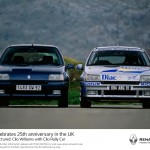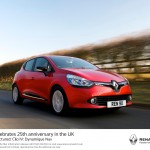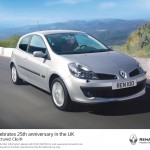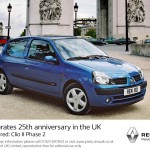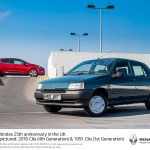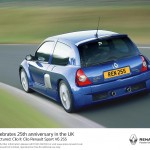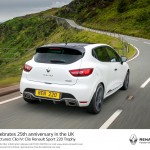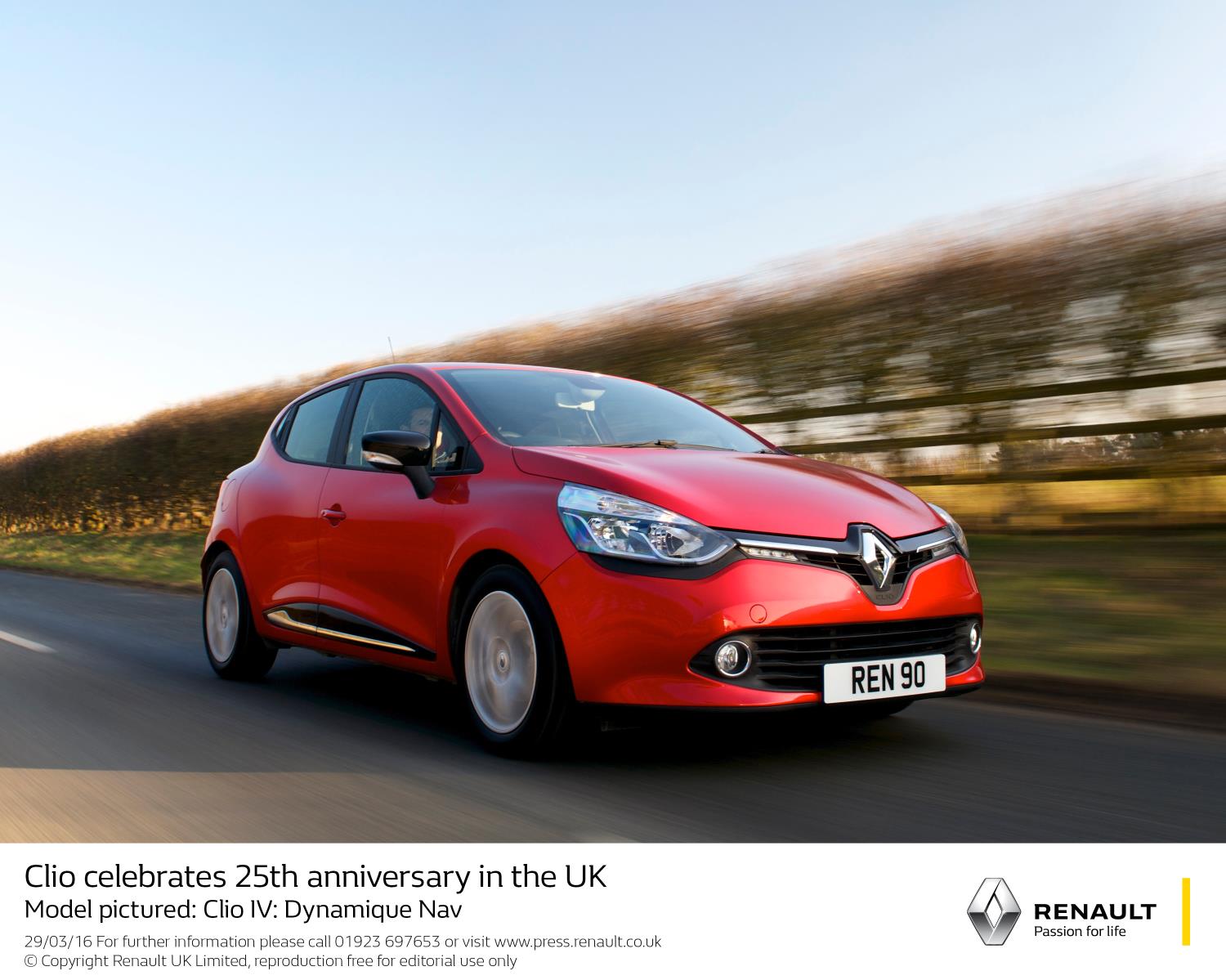
- Renault Clio celebrates 25 years in the UK
- Clio was originally launched in the UK on 29th March 1991
- Clio I set new standards in refinement and style for a supermini
- Weight-saving technologies and new safety tech introduced on Clio II
- Clio III gained the first five-star Euro NCAP rating in its class
- Current Clio IV introduced dynamic styling and advanced, ultra-efficient new engines
- Glorious heritage of Renault Sport Clios culminating in current 220 Trophy
- Clio has been involved in motorsport since launch
- First car to win title of European Car of the Year twice
- More than 13 million Clios have been sold globally since launch
It’s 25 years since Renault launched its all-new supermini for the 1990s, the Clio.
During the intervening years, and through four successive generations, it has become one of the world’s best-loved small cars: from a newly qualified driver’s first ‘wheels’, to a hugely popular and potent track day machine – the Clio has evolved into many guises, taken on many personas, but always with a unique sense of French style, quality and practicality. In the process it has flown high in the sales charts, and even spawned one of the most famous TV advertisements ever made. Over 13 million Clios have been sold around the world since launch – enough to line them all up bonnet-to-boot and circle the globe almost one and a half times – with over 1.2 million sold in the UK.
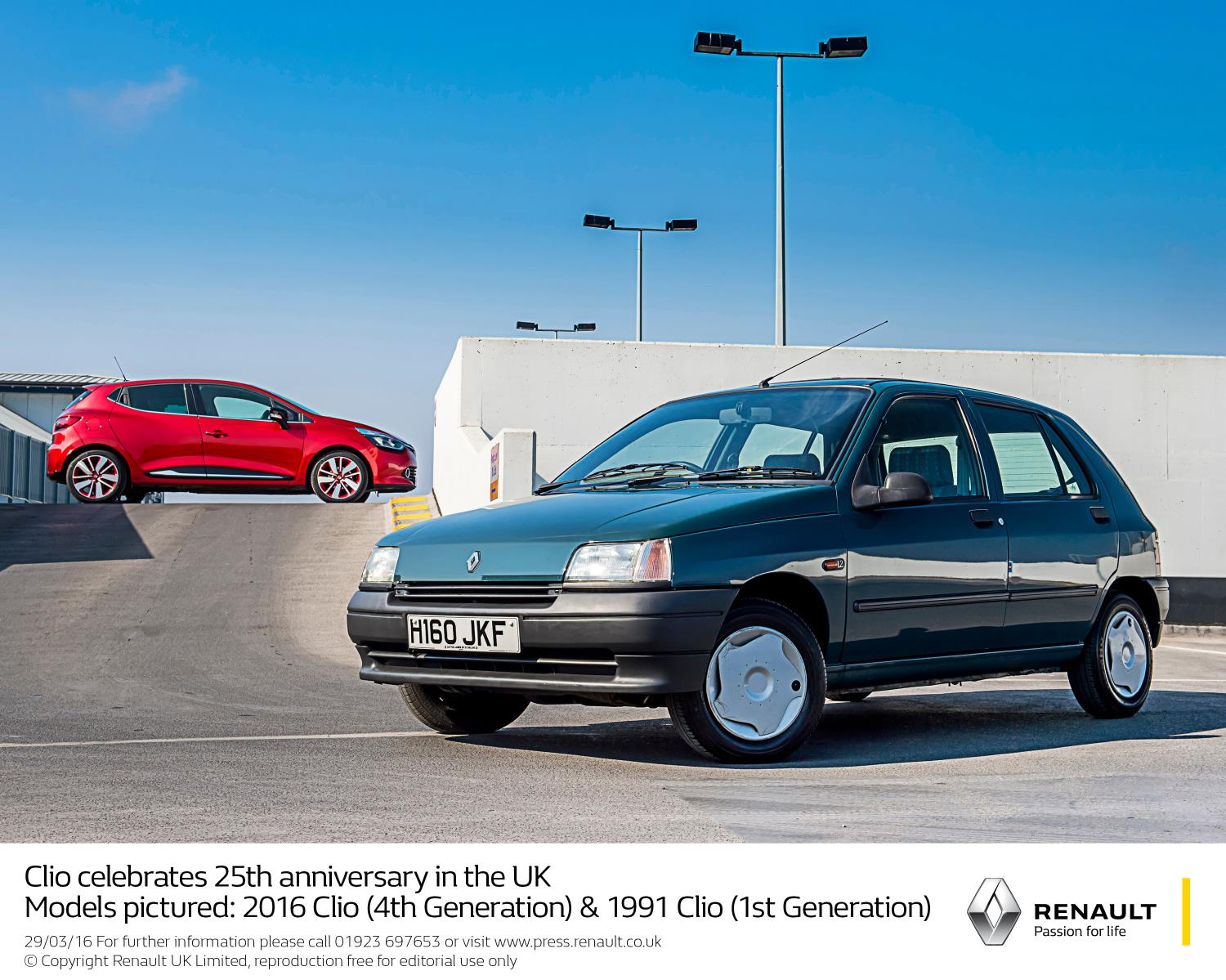
Clio 1: A new ‘big’ little car
The Clio story begins in 1990, during October at the Paris Motor Show, with the debut of a new Renault for the supermini class. Clio, taken from a Greek word meaning ‘made or to make famous’, the all-new car was naturally seeking to improve yet further on the qualities of the much-loved Renault 5. The principal aim of the new car was to ‘create big-car refinement in a small car’ – a ‘big’ little car, as it was referred to at the time. To that end, Renault made the car physically larger, some 2 inches longer and 2.5 inches wider, and increased the wheelbase and track to be the largest in the class to the benefit of ride comfort as well as handling. New ‘Energy’ engines of 1.2- and 1.4-litre capacity, and a high level of interior specification for the time, pushed the Clio even further upmarket.
The Clio I arrived in the UK on 29th March 1991 having already scooped the prestigious European Car of the Year award. In Britain, the range started with the RL 1.2 3-door at £7,190, and rose to the RT 1.4 five-door at £8,980; all models featured an extended eight-year corrosion warranty, with top-line RT specification bringing the sophistication of front electric windows, remote central locking and a stereo radio/cassette.
The European Car of the Year award was the ideal launch pad for the car, and sales for 1991 raced to 21,124 units in the UK. Another 34,701 were sold in the first full year of UK sales in 1992, aided by new arrivals to the range such as the 1.8-litre 16v hot hatch and the 1.9-litre diesel model.
A ‘phase 2’ model appeared in 1994 with minor styling changes, the Clio by now accounting for 49% of Renault UK sales alone and surging strongly into the UK top ten best sellers list.
Further design enhancements, along with improved safety measures and additional mechanical changes were instigated with the ‘phase 3’ models of 1996, with 1997 being the final year of Clio I production. Ironically, and proof as if it were needed as to the quality of the original concept, the Clio I had its best sales performance in the UK in its final year: 58,033 examples finding homes in the UK during 1997, taking the UK total to over 300,000 sales. The ‘big’ little car had exceeded even its own maker’s loftiest expectations.
Selling a new brand: Clio, Nicole and Papa, Thierry Henry and Va Va Voom
The Clio I’s UK promotion began on April 1st 1991, with a new TV advertisement featuring a young French woman, Nicole, her father, ‘Papa’, and a Provençal Chateau. In the classic first instalment, titled ‘Interesting’ and conceived by the Publicis Agency, the hinted at afternoon activities of father and daughter help sprinkle some continental flair over the new car, reinforced in 1992’s ‘The Date’, featuring a gleaming red Clio 16v. Over eight instalments, the development of the characters held such a grip over the nation that at one point Nicole, played by actress Estelle Skornik, was judged the second most recognisable person in the UK, ahead of the then-serving Prime Minister John Major, Chris Evans and Bob Hoskins. The final episode was aired in May 1998 for the launch of Clio II, with comedian Vic Reeves spurned by Nicole at the altar in preference to Bob Mortimer, in the process becoming one of the most watched TV adverts ever.
Nicole and Papa’s replacement arrived in the form of French actress Hélène Mathieu who starred in adverts for the Clio II called ‘Size Matters’ featuring the then newly-launched Clio Renault Sport 172.
The history continued with the French footballer Thierry Henry. Henry starred in multiple advertisements that famously discussed: “What is Va Va Voom?”. Once again, the Clio worked its way into the nation’s consciousness and affections, with the phrase ‘Va Va Voom’ entering the Oxford English Dictionary in 2004.
In 2006, new characters ‘Ben’ and ‘Sophie’ discussed the merits of the UK versus France for the Clio III, with the theme of ‘French Car, British Designers’. The ‘Va Va Voom’ theme returned in 2011 in a new advert starring American model, Dita von Teese.
The current UK Clio media campaign uses the theme ‘Be Moved. Not Driven.’ The campaign echoes all that makes Renault unique: a sense of joie de vivre, passion and romance at its heart, featuring a number of Clio IVs driven with members of a jazz band and two lovers atop each Clio roof.
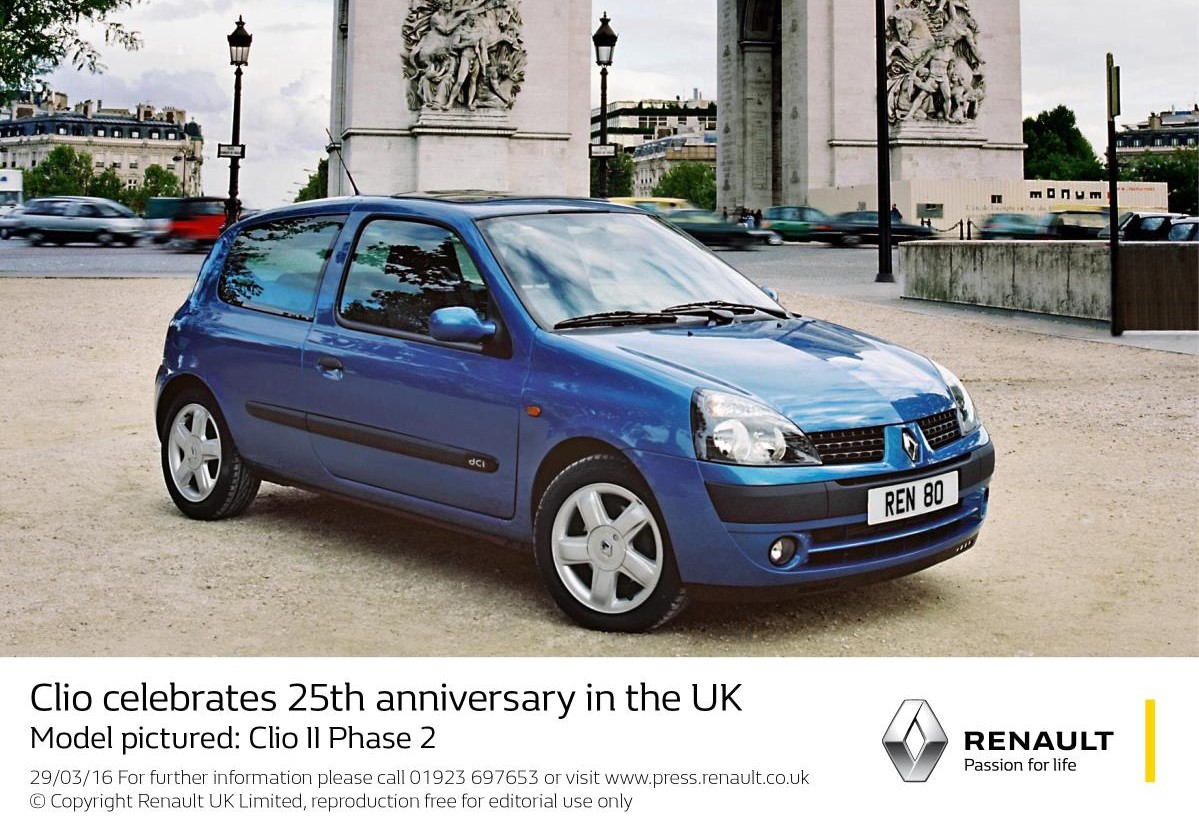
Clio II: The Clio matures, growing stronger and more sophisticated
The Clio II had a tough act to follow, given the Clio I had been in the UK top 10 sellers chart for the previous five years in a row. All-new, curvier bodywork clothed a car that had grown once again, but only by 6cm in length this time. Even so, a longer wheelbase realised more interior space, complemented by larger seats typically found in cars from the class above, and notably compliant bushing for the suspension; all to maximise the refinement for those on-board.
Advanced materials were incorporated to help reduce the weight of the car, such as polycarbonate headlamp covers, composite front wings and, on some models, an aluminium bonnet. Safety was also becoming ever more important, with ABS available on 50% of the range or as an option, a first for a supermini, as was the fitment of front side airbags. In fact, up to four airbags could be specified, along with seat belt pre-tensioners, and other comfort features including fingertip control for the sound system and the adoption of power steering. Renault was taking the art of the supermini to an entirely new level.
As a reflection of changing times, improved fuel consumption and emissions had also become more of a priority, with improvements of up to 15% on some models compared to its predecessor. In time, new 16-valve engines would boost Clio II’s performance in this area even further.
The new car arrived with a choice of four trim levels, with prices ranging from £8,350-£11,700. Minor changes took place in 2000 – along with a class-leading four-star Euro NCAP rating – with a ‘phase 2’ model appearing in 2001 that introduced sharper frontal styling, even better interior quality and a standout new engine: the 1.5-litre common rail injection turbo diesel.
2002 saw Clio II achieve its UK highest sales volume at 86,337.
Yet more minor changes were made for ‘phase 3’ models in 2004, recognisable by their grey headlamp bezels instead of black, and digital fuel and water temperature gauges in the cockpit. The Clio II had to face the challenge of ‘difficult second album’ syndrome, but it’s enduring popularity, including living on after the introduction of Clio 3 as the Clio Campus, proved the inherent ‘rightness’ of its design.

Clio III: new levels of safety and luxury for the supermini class
The Clio III made its debut at the 2005 Frankfurt Motor Show, and was available to order in the UK from August of that year. It marked another shift in the development of the small car as a whole: larger again in dimensions, and the first car in its market segment to be awarded a five-star Euro NCAP rating, the Clio III brought new levels of quality and sophistication to the supermini class. Particularly notable was the use of soft-touch materials on higher spec versions, giving an ambience far removed from that of a traditional small car. Other ‘big car’ features included a tyre pressure monitoring system and Renault’s ‘hands free’ card, instead of a traditional key.
The toil of the designers and engineers was rewarded by winning European Car of the Year for 2006, making the Clio the first car to win the coveted prize twice (firstly with the Clio I in 1991).
Originally available only as a three-door model, with the five-door variant arriving early in the new year, the Clio III could be specified in four trim levels – Extreme, Expression, Dynamique and Dynamique S – and ranged in price from £8,895 to £12,650. A new engine range reflected the inexorable rise of diesel as a fuel choice for small cars, with an equal number of petrol and diesel options: three 16v petrol engines of 1.2-, 1.4- and 1.6-litres were complimented by the 1.5 dCi engine in 68hp, 86hp and 106hp variants.
In 2009 the Clio III morphed into a ‘phase 2’ model, with significantly altered frontal styling, and further improved interior quality and specification. A sporty GT model was introduced and helped bridge the gap between the regular range structure and the Renault Sport derivatives. Over the course of its life, the Clio III brought new levels of quality and, crucially, safety to the class, shifting consumer expectation forever in the marketplace.
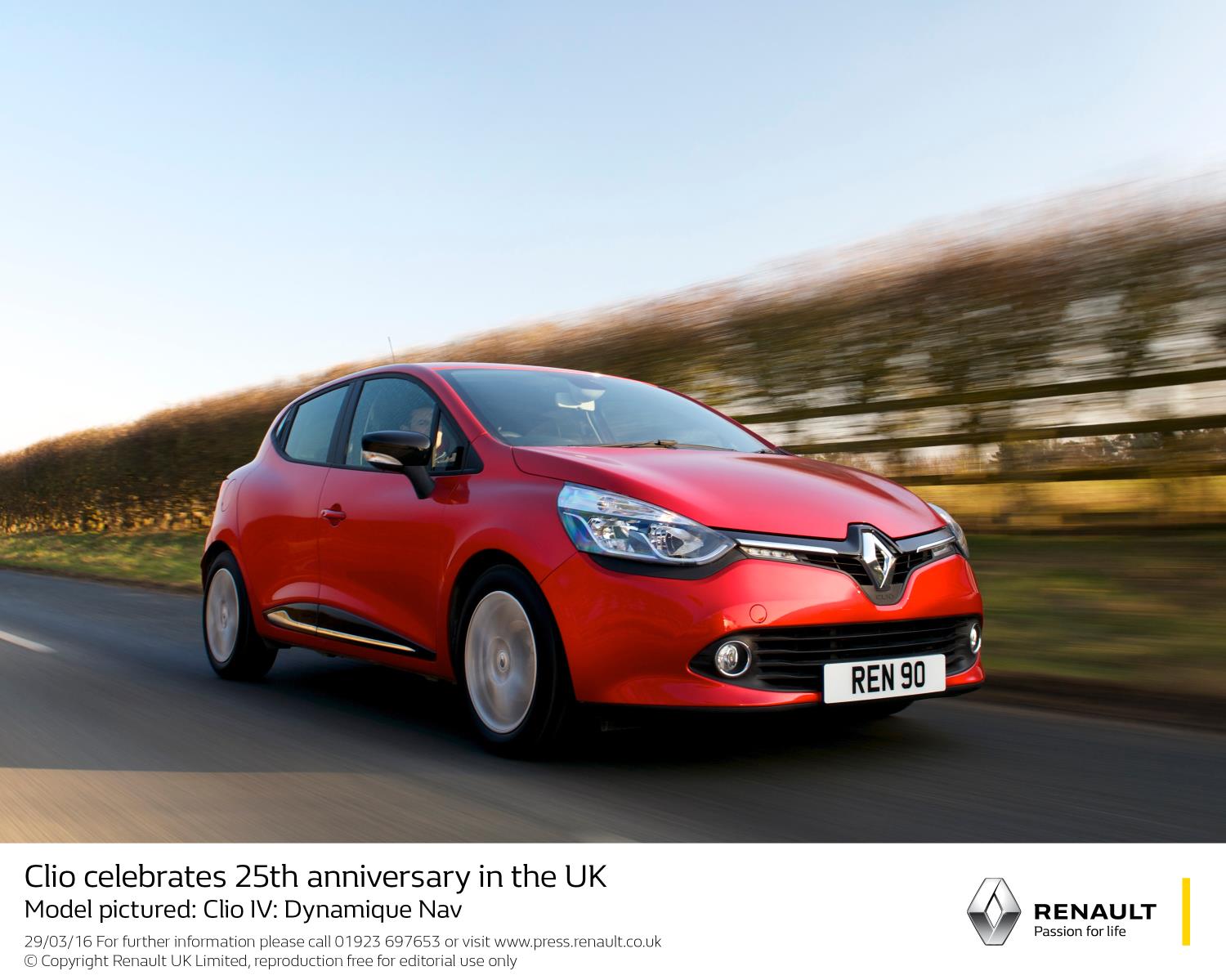
Clio IV: “simple, sensuous and warm”, with cutting edge technology
The Clio IV was the first all-new Clio to be designed under the watch of Renault’s current Head of Design, Laurens van den Acker. Unveiled at the 2012 Paris Motor Show, it deliberately set out to reinterpret the more dynamic visual qualities of the earlier Clios, while a longer body and significantly increased wheelbase improved even further the roominess within the car. Described as “simple, sensuous and warm”, the design of the five-door only Clio IV apes the coupe-like form of a three-door vehicle, with a lower roof than Clio III, a body that’s nearer to the ground and a wider track. The fourth generation Clio was heavily inspired by van den Acker’s striking 2010 DeZir concept and established the now familiar Renault design language that has been seen on every new Renault since then.
Renault’s prowess with turbocharging technology has realised an advanced range of petrol and diesel engines, with a naturally aspirated 1.2-litre 75hp engine complemented by a 0.9-litre, three-cylinder TCe with 90hp and a 1.2-litre TCe offering 120hp. The 1.5-litre dCi engine now boasts an incredible 88.3mpg combined fuel consumption figure, while the standard five-speed manual gearbox is joined by the option of Renault’s new six-speed dual-clutch gearbox, EDC – unimaginable technology in the era of the original Clio.
Inside the Clio IV, a striking dashboard design in the shape of an aircraft’s wing is combined with a tablet-style facia with the option of Renault’s new R-Link integrated touchscreen, a bridge between the world of motoring and the connected world outside, with TomTom navigation and a catalogue of available apps. A personalisation programme allows buyers the freedom to specify their Clio like never before: a fitting new chapter in the life of the ‘big’ little car that grew up over the course of 12 million sales and counting.
Other varieties of Clio
The Clio has had a presence on the global market not just as the familiar hatchback, but also as a popular van, and in additional body styles. A saloon version of the Clio II, known as Symbol, was sold in various markets across central and eastern Europe and beyond, with the Clio III also available in a Sports Tourer version between 2008 and 2012 in the UK. The Clio IV is also available as an estate variant in certain markets.
Sporting Clios: 16 valves, Williams, and the birth of Renault Sport
Renault wasted no time in bringing the first sporting Clio to market, debuting the Clio 1.8 16V in the latter part of 1991; hardly surprising when you consider the brand’s fabulous history with performance derivatives, including the Renault 5 Turbo and 5 GT Turbo.
Fitted with a 1.8-litre, 16-valve engine producing 137hp, it was instantly recognisable thanks to the power bulge on the bonnet and flared wings. In 1993, Renault took the Clio 16V to new heights, and in the process created arguably the most famous hot hatch of all time: the Renault Clio Williams. Built to celebrate Renault’s Formula One World Championship wins with Williams and to fulfil Renault Sport’s ambitions in rallying, the ‘Williams’ featured a 2-litre version of the 16V’s engine producing 150hp, with a wider track and a close-ratio gearbox amongst many enhancements. Originally marketed as a limited edition, it appeared in a further two distinct series, in the process establishing blue paintwork with gold wheels as an iconic livery.
However, it was a year after the introduction of the Clio II that the family tree of Renault Sport Clios, revered to this day, began as we now know it. The original was known as the Clio Renault Sport 172 – the first to be sold under the Renault Sport sub-brand – and combined a new 2-litre engine producing 172hp with the classic hot hatch staples of wider wheel arches, larger wheels and a sporty interior. Immediately establishing itself as the class leader, the 172 evolved with a ‘phase 2’ version in 2001, and was offered in lightweight ‘Cup’ form during 2002 – where lightweight glass was fitted and even the ABS system was omitted to save weight – before becoming the ‘phase 3’-based ‘182’ version for 2004. This model was also available as a Cup variant, before the ultimate 182 Trophy models appeared in 2005, featuring exotic Sachs remote-reservoir suspension in a limited run of 500 cars for the UK market and 50 for Switzerland.
The Clio II also provided a much more exclusive, extreme performance hatchback in the form of the Clio V6. Originally built as a showcar for the 1998 Paris Motor Show, an incredible public reaction saw this car become a reality. Based on the Clio Trophy racing car, a 3-litre, 230hp V6 engine now sat where the rear-seats once were, and the resulting broad-shouldered design had the road presence to outdo many a supercar. The ‘230’ model was replaced by a ‘phase 2’ 255hp version in 2003. Built in limited numbers, values are rising today in the collectors’ market for these unique, hand-built baby supercars.
The next instalment arrived in the form of the Clio III-based ‘197’ model of 2006 featuring, as the name implies, a 197hp engine with a new six-speed gearbox and careful attention to aerodynamics that included a functioning rear diffuser – inspired by Formula One. An R27 F1 Team version – built to celebrate Renault’s back-to-back F1 World Championships in 2005 and 2006 – followed, before the type evolved into the ‘200’ model during 2009, with more power and torque amongst Renault Sport’s fine tuning. In 2012 Renault capped a glorious era with the Raider limited edition, featuring matt grey or red paintwork, leather upholstery and black 18” alloy wheels.
In 2013 a new lineage began with the arrival of the Clio IV Renault Sport 200, powered by a turbocharged 1.6-litre engine connected to a dual-clutch ‘EDC’ gearbox for greater performance and usability. In familiar Renault Sport tradition, an even more potent version debuted in 2015 known as the 220 Trophy, featuring more power, a lower, firmer chassis set up and even quicker gearshifts.
No other manufacturer has so keenly supported the affordable performance car market in recent decades, with Renault Sport’s vast and loyal fan-base a testament to that commitment.
Clio in Motorsport
With Renault boasting a proud history across many forms of motorsport, it’s no surprise that the Clio has featured heavily in the brand’s sporting activities.
In the UK, the Clio is best known for the Clio Cup one-make racing championship. The Renault-backed series can trace its roots back to 1974, when the Renault 5 was the featured car. Following different iterations of the 5, including the 5 GT Turbo in the late 1980s, the Clio took over in 16v form for 1991, and apart from a brief switch to the Renault Sport Spider in the late 1990s, it’s been Clio all the way.
The current championship, with 23 cars announced for the 2016 grid, uses the latest Clio IV with its 1.6-litre, 220hp turbocharged engine. Once again, the Clio Cup will support the British Touring Car Championship (BTCC) in 2016, for the 26th consecutive year, ensuring a large audience both at the circuit and on TV.
The close racing of the Clio Cup has assisted the careers of many future racing stars, including Jason Plato (1996 champion), Andy Priaulx (1999 Champion), Tom Onslow-Cole (2006 champion) and future BTCC champ Andrew Jordan, who competed in the Clio Cup during 2007. In fact, Renault is represented at every level of the sport, from official Renault Sport track days to the Renault Sport F1 Team, with racing championships such as the Clio Cup and Formula Renault 2.0 in between.
In rallying, the Clio has featured in the sport from the early days of the 16v model. It was this motorsport discipline that inspired the famous Clio Williams, which in the hands of French ace Jean Ragnotti has provided fans with some of the most spectacular ‘sideways’ driving ever seen on a rally stage. The Williams evolved into the Clio ‘Maxi’ for 1995 under the ‘Kit car’ rules of the period, with a wider body, improved aerodynamics and up to 275bhp available from a very highly tuned version of the road car’s engine.
Various models based on Clio II and Clio III followed, culminating in the current Clio R3T, based on the Clio Renault Sport 200 EDC. This features a 242hp engine, a six-speed sequential gearbox, and all the performance and safety equipment required to compete successfully in rallying.
Clio: Redefining the small car segment
The Clio certainly had a lot to live up to, following as it did in the tyre tracks of the classic Renault 4 and Renault 5 models. Both had made a major contribution to the development of the modern supermini, but it’s a testament to the enduring appeal of this ‘big’ little car that it has outgrown even them in the affections of the car-buying public. After 25 years and many millions of sales, the Clio is still redefining the small car segment through technology, refinement and style.
Clio sales figures
| Model | Year | Global sales | UK sales |
| Clio I | 1991-2000 | 3,751,981 | 334,944 |
| Clio II | 1997-2016 | 5,588,799 | 577,061 |
| Clio III | 2005-2016 | 2,463,144 | 213,274 |
| Clio IV | 2012-2016 to date | 1,227,148 | 77,750 |
| TOTAL | 1991 to date | 13,031,072 | 1,203,029 |
Then and Now…
| Clio I – 1991
RN 1.2 5-door |
Clio IV – 2016
Dynamique Nav TCe 90 5-door |
|
|
|
|
|
|
|
|
|
|
|
|
|
|
|
|
|
|
|
|
|
|
|
|
|
|
|
|
| 0-62mph in 15.2 seconds |
|
|
|
|
|
ENDS

